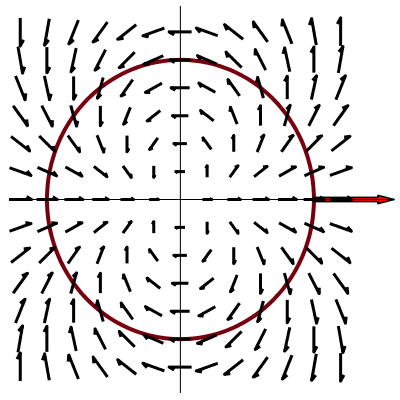Vortices and Quantised Circulations
What happens when a superfluid rotates around a point? Like many of the properties of superfluid, the rotational properties of He II are unnatural and unintuitive. The particular form of the superfluid velocity equation leads to the circulation of the flow being quantised and vortices being present throughout the rotating fluid.
Irrotational Flow
The expression for the superfluid velocity is \(\mathbf{v_s} = \frac{\hbar}{m}\nabla\theta\). The fact that the velocity depends on the gradient of a function means that the velocity has zero curl. This is because the curl of a gradient is always equal to zero ie.
\(\nabla \times \frac{\hbar}{m}\nabla\theta=0\)
Rotating a cylindrical container of superfluid should then not create any rotation whatsoever and yet it does! The solution comes in the form of circulation quantisation and a high number of vortices.


Circulation Quantisation
Using the expression for the velocity and the definition of a circulation
\(\kappa = \oint\mathbf{v_s}{\cdot}d\mathbf{r} = \frac{\hbar}{m}\oint\nabla\theta{\cdot}d\mathbf{r} = \frac{\hbar}{m}\left(\theta(\mathbf{r_2})-\theta(\mathbf{r_1})\right)\)
but \(\mathbf{r_1}=\mathbf{r_2}\) as the integral was over a closed contour so the start and end points are the same point. To ensure that the macroscopic wavefunction is still unique, the angle can only vary by an integer multiple of \(2\pi\). Therefore the circulate \(\kappa = \frac{2\pi\hbar}{m}n=\frac{h}{m}n\) is quantised in integer multiples of \(\frac{h}{m}\) - the quantum of circulation.
The integer n gives the topological winding number of the circulation. It measures the number of times the phase rotates by \(2\pi\) in the anticlockwise direction along the contour. Fig 2 shows a vector field and contour in which the winding number is \(n=2\).
Vortices
Despite being irrotational, the surface of He II in a rotating container still exhubits a centrifugal force and the fluid level dips in the centre of the container. Suppose the superfluid contained many cylindrically symmetric vortices with an associated velocity field
\(\mathbf{v_s} = \frac{\kappa}{2{\pi}r}\mathbf{\hat{\phi}}\)
This field is irrotational \(\nabla \times \mathbf{v_s} = 0\) everywhere except at the origin where it blows up. The macroscopic wave function is \(0\) at the origin and so \(n_s\) is also \(0\). Therefore there is no current in the vortex core despite the singularity in the velocity.
This superfluid flows faster as it gets closer to a vortex core but the important thing to note is that it can still be seen to be going in circles. Therefore, the centripetal force still acts on the fluid, causing the dip in the surface of the fluid.
The most frequently occuring vortex have \(n=\pm1\) as these have the lowest energy. Each vortex thus adds a quantum of circulation to the flow and so for a macroscopic rotation large enough to cause a dip in the surface, there must be many vortices within the fluid.
Quantised vortices are quite general and occur in many areas of physics including condensed matter systems and electromagnetic fields.